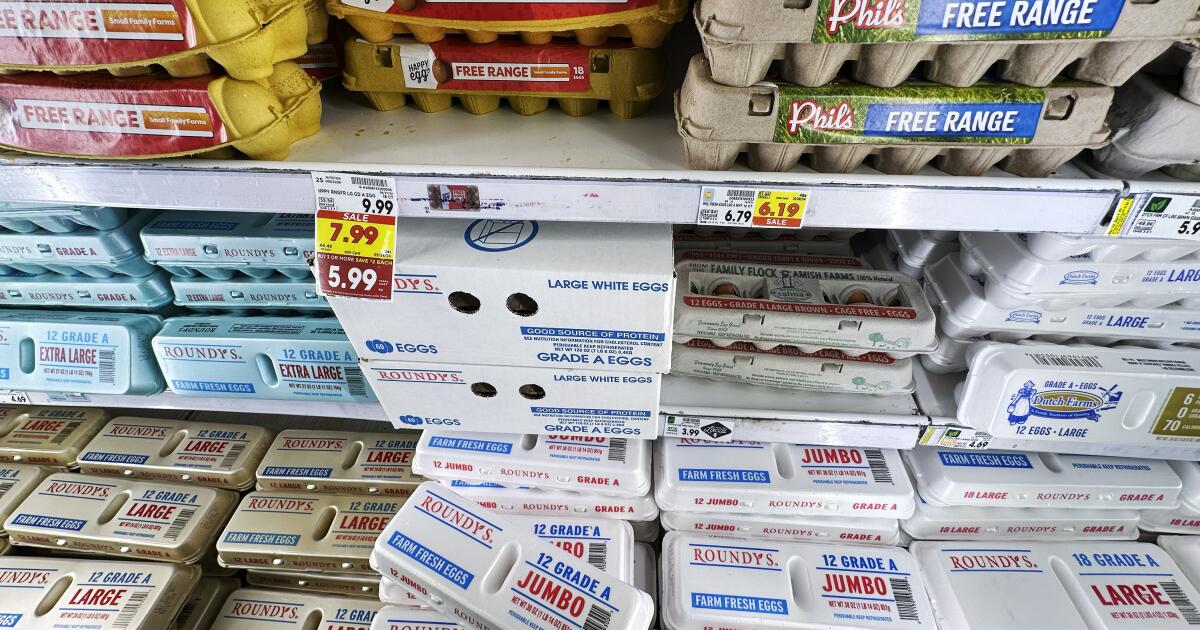About $9 a dozen: Why egg prices are rising and for how long

A bird flu outbreak has Californians paying higher prices for eggs, and shoppers are sometimes scrambling to find a carton of eggs amid supply disruptions that have left some shelves empty.
The average price of a dozen large eggs rose sharply in California in December to $8.97, up from $5.68 in late November, and remained at that price earlier this year, according to a report from the US Department of Agriculture.
Some stores, including Ralphs in El Segundo, have posted signs explaining that the recent egg shortage is due to the “cost of obtaining cage-free eggs,” a result of California's Proposition 12, which takes effect in 2022 and requires chickens to be kept in cages.
However, the latest and greatest volatility in the market is due to bird flu.
Several restaurants have started raising their prices to reflect the higher cost of eggs.
Restaurant manager Lyndsey Stevens of Boss Hogg's Country Kitchen in Farmersville, Calif., told KFSN-TV in Fresno that the increased costs have forced the restaurant to seek cheaper prices for eggs to avoid passing the cost on to customers.
But on the central coast, San Luis Obispo restaurant Bon Temps Creole raised its $15 menu with two eggs to $17, KSBY reported.
A persistent and significant outbreak of highly pathogenic avian influenza has decimated California's chicken flocks and is therefore damaging the egg supply chain, according to the USDA's latest egg report.
Bird flu viruses are spread through direct, bird-to-bird contact. They can also spread on contaminated surfaces or materials, such as manure, egg trays, crates, clothing and hands.
Once the virus is detected, the flocks are culled and it takes several months to repopulate the farm, California Poultry Federation president Bill Mattos told the Ventura County Star.
This disease has been causing damage to egg farmers since it started in February 2022.
Last month, the USDA reported nine confirmed cases of bird flu at large and small operations in Merced, Stanislaus, Riverside and San Joaquin counties.
Increased demand for eggs and baked goods during the holiday season has made losses especially painful for shoppers at supermarkets.
The disease has had a major impact on large flocks of egg farms from October to January, with the worst hitting in December, according to the USDA.
In the past 30 days, the outbreak has affected 10.16 million birds across the US, the USDA said. But the number of infected birds is part of the more than 378.5 million egg-laying chickens in the United States, according to data from the National Agricultural Statistics Service.
Still, California has been the hardest-hit state and it continues to be a rocky start to the year for farmers as the USDA reported one new case of bird flu in Stanislaus County affecting 75,200 birds.
The incidence of bird flu is high in the fall and spring because wild birds spread the virus to laying hens as they migrate to their homes at certain times of the year, the expert said.
That means consumers can expect the price and availability of eggs to continue to fluctuate, says the American Farm Bureau Federation.
Source link



